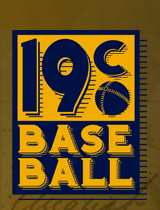Displaying results: 21 - 30 Total results: 80- 21. Baseball History: 19th Century Baseball: The Rules: History of the Strike (Continued)
- ... Home and Third Bases, without interference by a Player. Provided, that a Foul Hit not rising above the Batsman's head and caught by the Catcher playing within ten feet of the Home Base, shall be termed a Foul Tip. The batter was out if a Foul Hit was caught before touching the ground ... Home and Third Bases, without interference by a Player. Provided, that a Foul Hit not rising above the Batsman's head and caught by the Catcher playing within ten feet of the Home Base, shall be termed a Foul Tip. The Players' National League of Base Ball Clubs, during their only season...
http://www.19cbaseball.com/rules-8.html
- 22. Baseball History: 19th Century Baseball: Image: Bases and Foul Lines: 1860: National Association of Base-Ball Players
- ... foul territory. Generally the flag attached to each post contained the colors of the home club. The third and first base foul lines were not specified in the playing rules to be marked on the playing field. The dotted lines in this diagram show the position of the four bases in relationship to each other. Click diagram to return to previous page. HOME...
http://www.19cbaseball.com/image-bases-and-foul-lines-1860.html
- 23. Baseball History: 19th Century Baseball: Image: Bases and Foul Lines: 1845–1856
- ... "diamond" was 105 feet, making the distance between the bases 74.25 feet. The third and first base foul lines were not specified in the playing rules to be marked on the playing field. The dotted lines in this diagram show the position of the four bases in relationship to each other. Click diagram to return to previous page. HOME...
http://www.19cbaseball.com/image-bases-and-foul-lines-1845-1856.html
- 24. Baseball History: 19th Century Baseball: Image: Bases and Foul Lines: 1857; 1858–1859: National Association of Base-Ball Players
- ... in 1857 it was agreed that first, second and third base must cover one square foot. The third and first base foul lines were not specified in the playing rules to be marked on the playing field. The dotted lines in this diagram show the position of the four bases in relationship to each other. Click diagram to return to previous page. HOME...
http://www.19cbaseball.com/image-bases-and-foul-lines-1857-1859.html
- 25. Baseball History: 19th Century Baseball: Image: Bases and Foul Lines: 1861–1867: National Association of Base-Ball Players
- ... and Foul Lines: 18611867: National Association of Base-Ball Players. Starting in 1861, third and first base Foul Ball Lines were first specified in the playing rules to be marked on the playing field. They extended from the center of Home Base to the 30 yard mark at third and first base only. Click diagram to return to previous page....
http://www.19cbaseball.com/image-bases-and-foul-lines-1861-1867.html
- 26. Baseball History: 19th Century Baseball: Image: Bases and Foul Lines: 1868–1870: National Association of Base-Ball Players
- ... and Foul Lines: 18681870: National Association of Base-Ball Players. Starting in 1861, the third and first base Foul Ball Lines were specified in the playing rules to be marked on the playing field. They extended from the center of Home Base to the 30 yard mark at third and first base only. De Witt's Base-Ball Guide...
http://www.19cbaseball.com/image-bases-and-foul-lines-1868-1870.html
- 27. Baseball History: 19th Century Baseball: Image: Bases and Foul Lines: 1877: National League of Professional Base Ball Clubs
- .... The rules for the 1877 season stated that 15' and 50' lines, corresponding to the Foul Ball Lines, were specified to be marked on the playing field. These lines were drawn to aid the umpire in keeping the players and coaches the correct distance from the playing field. Their lengths were not specified. Click diagram to return to previous page. HOME | SITE INDEX | CONTACT US | E-MAIL 2007 19c Base...
http://www.19cbaseball.com/image-bases-and-foul-lines-1877.html
- 28. Baseball History: 19th Century Baseball: Image: Bases and Foul Lines: 1880–1881: National League of Professional Base Ball Clubs; 1882–1883: American Association of Base Ball Clubs
- ... and the 50' line was named the Player's Line. Their distances still corresponding to the Foul Ball Lines and were specified to be marked on the playing field. These lines were drawn to aid the umpire in keeping the players and coaches the correct distance from the playing field. Their lengths were required to extend to the limits of the grounds. Click diagram to return to previous page. HOME | SITE INDEX | CONTACT US...
http://www.19cbaseball.com/image-bases-and-foul-lines-1880-1881.html
- 29. Baseball History: 19th Century Baseball: Image: Bases and Foul Lines: 1890: Players' National League of Base Ball Clubs
- ... 1880, the 15' line was named the Coach's Line. The distance corresponding to the Foul Ball Lines and were specified to be marked on the playing field. These lines were drawn to aid the umpire in keeping the coaches the correct distance from the playing field. In 1887, the Coach's Line was required to begin 75 feet from the Catcher's Line. The Players' League did not mandate...
http://www.19cbaseball.com/image-bases-and-foul-lines-1890-pl.html
- 30. Baseball History: 19th Century Baseball: Image: Bases and Foul Lines: 1894–1899: National League and American Association of Professional Base Ball Clubs
- ... and the 50' line was named the Player's Line. Their distances still corresponding to the Foul Ball Lines and were specified to be marked on the playing field. These lines were drawn to aid the umpire in keeping the players and coaches the correct distance from the playing field. In 1887, the Coach's Line was required to begin 75 feet from the Catcher's Line and extend to the limits of the ground...
http://www.19cbaseball.com/image-bases-and-foul-lines-1894-1899.html
Result page: << Previous 1 2 3 4 5 6 7 8 Next >>

